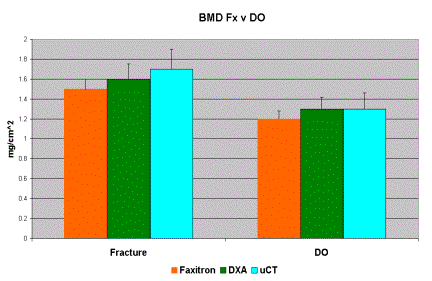Sunday, September 25, 2005 - 2:45 PM
8721
Dual Energy X-Ray Absorptiometry vs. mCT Analysis of BMD in Mandibular Distraction Osteogenesis
Introduction: Objective criteria assessing bone healing in mandibular distraction osteogenesis (DO) do not currently exist. Our aim is develop and test non-invasive ways to quantify bone healing in the regenerate in order to guide clinical decision making as well as provide evidence based approach to judge outcomes. While dual energy X-Ray absorptiometry (DXA) is used clinically, its use has not been extended to assess DO and fracture healing of the mandible. Our specific aim was to evaluate the efficacy of DXA when compared to X-ray Faxitron and micro-CT (µCT), the current non-clinical “gold standard” of non-destructive bone density evaluations. To our knowledge this is the first reported use of DXA to assess DO and fracture healing the mandible.
Methods:A modified Ilizarov-type, external fixator was placed on the mandible of 400g male Sprague-Dawley rats. A unilateral vertical osteotomy is created in the body, posterior to the 3rd molar. Mandibles are harvested en-block. Imaging:µCT (GE Healthcare Biosciences) images were obtained by scanning and reconstructing at a 45voxel size. DXA (Norland Sabre) images were obtained using a scan rate of 3mm/s with 0.2 x 0.2mm resolution. Faxitron radiographs (MX-20, Faxitron x-ray corporation) were obtained at 3x magnification with an exposure of 13s at a 25kV potential, and calibrated using an aluminum step-wedge. Regions of interest were selected using anatomical and surgical landmarks, directly behind the 3rd molar, and centered to encompass most of the gap (for DO and Fx groups) or matching the contralateral side (control). Measurements were established so ROIs were comparable between the imaging modalities. Groups of n = 11 for DO and n =7 for Fx. Values as mean +/- SD. Student's paired t-tests were used to compare the surgery site with control mandibles for each imaging modality, and independent t-tests were used to compare DO and Fx measures. The results were considered to be significant if p < 0.05.
Results: BMD was significantly lower in both the DO gap and fracture sites when compared to their respective controls (p<0.01). No significant differences were found when comparing the Fx and DO sites independently in all three imaging studies. Finally, no differences were found when comparing DXA versus Faxitron, DXA versus µCT, or Faxitron versus µCT. Thus, all imaging modalities provided no significant difference in measuring BMD.
Conclusions:Our data supports the use of DXA as a cost-effective, time efficient, and potentially non-invasive quantitative imaging modality to objectively assess bone healing for both fracture repair and distraction regenerates in the mandible.
View Synopsis (.doc format, 190.0 kb)
See more of Cranio/Maxillofacial/Head & Neck
Back to 2005am Complete Scientific Program


